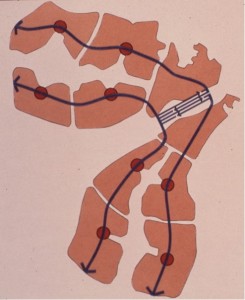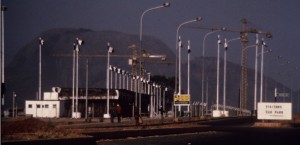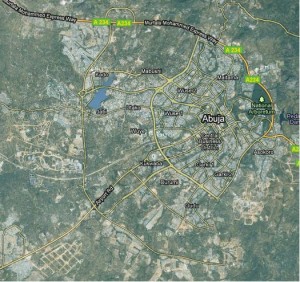There seems to be little question that we are now in one of those historically recurrent periods of societal crisis that tell us we must change our ways. A plethora of recent books present dismal perspectives of our clash of cultures, changing climate, losses of species and languages, and financial crises, and how each threatens our well-being and lastingness. The threats are very real, of course, but to me are interesting because, if relief is to be found, surely our infrastructure must have an important role.
Seeking to understand this role, I have finally plowed my way through Raj Patel’s modestly titled exegesis on modern economics and human nature, The Value of Nothing: How to Reshape Market Society and Redefine Democracy. (2009, New York: Picador) With ample reference to both foundational and more radical texts of market economics and Western social theory as well as more personal accounts of current populist movements, the book has definitely generated buzz and expanded its author’s reputation to sometimes messianic proportions. (For a review, see “Are You the Messiah? A political economist gets a following he wasn’t expecting,†by Lauren Collins, New Yorker magazine, November 29, 2010)
The reading took longer than expected, because as page after page turned I felt compelled to pencil in questions, opposing references, and outright objections to Patel’s perspectives. Where he sees elemental democracy in the masked pronouncements of a Zapatista Junta, I see the tyranny of the mob. When Patel disparages the possibility of getting prices right—or having any prices at all—for clean air and water, I despair at the idea that humans will forsake the desire to improve their lives, however privileged they may be, satisfied that their needs—defined by others—are being met. While Patel finds it essential to feed the world’s growing population by rationing necessarily limited food production, I wonder why humanity might not be happier and arguably better off limiting population to levels supportable with an abundant and varied food supply. I suppose I must recommend the book at least because it offers the attentive reader ample intellectual stimulation.
Patel’s message seems to be that for two key reasons a market-based, democratic society is essentially unsustainable and revolutionary change is essential. First, there is no hope of getting the prices right for clean air, pure water, cultural diversity, historic associations, and myriad other resources we humans use in pursuit of comfortable lives. Second, our abilities as humans to work together toward success in this pursuit are hopelessly subverted by the existence of corporations, disembodied entities that behave with the legal rights and powers of a person but lack a person’s moderating moral and ethical judgment.  Without the restrictive forces of either appropriate prices or moral imperatives, corporations and people ruthlessly seek exclusive control of collective resources and private gain from exploitation of these resources.
Hope lies, for Patel, in a Buddhist theory of value.  “The real value of something,†he writes, “is not its ability to satisfy a craving, a desire, a vanity, but to meet the need for well-being.â€Â With enlightenment, we will recognize that our desire for cell phones, shoes, and other such “baubles and fripperies†is nothing but illusion created by hidden persuaders. Corporations will somehow adapt, I suppose, and we will lose our lust for more, all settling happily for just “enough.â€
British economist Diane Coyle’s book The Economics of Enough: How to Run the Economy as if the Future Matters. (2011, Princeton, NJ: Princeton University Press) takes a similar stance on the problems but offers a more moderate assessment of the underlying issues and, to my mind, a more practical prescription for what must be done. She focuses her attention on the inevitable necessity of making tradeoffs among efficiency, fairness or equity, and freedom in how people are able to pursue and manage their resources. Our values and our governance, as individuals and groups within our society, determine how the balance is struck, and today we have “tilted too farâ€â€”in Coyle’s view and my own—“in favor of individualism and the gratification of immediate wishes,†toward freedom at the expense of fairness and even efficiency. Where previous generations made investments, we now are consuming our assets.
Regarding values, Coyle’s views are not so different from Patel’s: We need a change of values to guide our behavior. In Coyle’s analysis, however, a revival of what Max Weber termed the Protestant ethic, principles that guided people to work for the future rather than immediate gratification, could be effective.  Neither author has much to say about how we are to decide what is “enough†for individuals and groups in a pluralistic society. Patel would no doubt be the more austere judge.
To Patel’s call for changed values, Coyle adds changes in measures of achievement and in our institutions of governance. The ways we measure economic growth, productivity, and well-being are simply inadequate for dealing with our growing understanding of the importance of intangibles. With the revolution in information and communications technologies, services account for an ever larger share of production; we do a poor job of measuring quality of services, and the shortcoming is especially severe regarding what we term quality of life matters. The technology revolution is also transforming how individuals, corporations, and political entities relate to one another. Coyle imagines that societal decision making can be shifted from centralized agencies to “involve a more productive and thoughtful interplay between markets and governments than we’ve typically had in the past…â€, but here I could not quite make out her image of that future. Perhaps she envisions social networking platforms supporting grass-roots participation, a sort of Swiss direct democracy via telethon or Facebook.
Development of such a participatory system would certainly signal the integration of a new set of technologies into our infrastructure. In past decades, new infrastructure technologies have been accompanied by—and arguably enabled or perhaps caused—changes in how society operates. Rail and then highway transportation changed the patterns of human settlement; piped supply of clean water changed the way households operate. These changes in turn have been accompanied by changes in our fundamental values, on the scale contemplated by Patel and Coyle.  If we are to have the change in values these authors argue we need for a sustainable future, then I believe we must expect to reshape our infrastructure.




